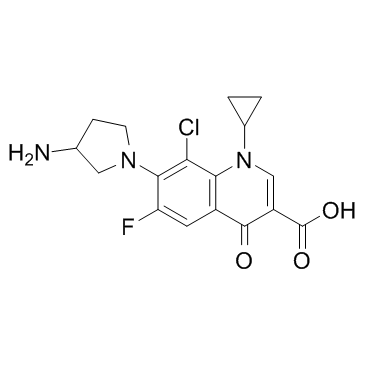Clinafloxacin

Clinafloxacin structure
|
Common Name | Clinafloxacin | ||
|---|---|---|---|---|
| CAS Number | 105956-97-6 | Molecular Weight | 365.78700 | |
| Density | 1.573 g/cm3 | Boiling Point | 592.3ºC at 760 mmHg | |
| Molecular Formula | C17H17ClFN3O3 | Melting Point | 253-258ºC | |
| MSDS | Chinese USA | Flash Point | 312ºC | |
| Symbol |

GHS08 |
Signal Word | Warning | |
|
Pharmacokinetics of danofloxacin and N-desmethyldanofloxacin in adult horses and their concentration in synovial fluid.
J. Vet. Pharmacol. Ther. 38(2) , 123-9, (2015) The objectives of this study were to investigate the pharmacokinetics of danofloxacin and its metabolite N-desmethyldanofloxacin and to determine their concentrations in synovial fluid after administration by the intravenous, intramuscular or intragastric rou... |
|
|
Accumulation of garenoxacin by Bacteroides fragilis compared with that of five fluoroquinolones.
J. Antimicrob. Chemother. 52(4) , 605-9, (2003) Garenoxacin is a novel des-F(6)-quinolone with good anti-anaerobe activity. The accumulation of garenoxacin and five other quinolones in the presence and absence of a variety of efflux pump inhibitors, including carbonyl cyanide m-chlorophenyl hydrazone (CCCP... |
|
|
Synthesis and antibacterial activity of novel pyrido[1,2,3-de][1,4]benzoxazine-6-carboxylic acid derivatives carrying the 3-cyclopropylaminomethyl-4-substituted-1-pyrrolidinyl group as a C-10 substituent.
J. Med. Chem. 51 , 3238-49, (2008) Novel pyrido[1,2,3- de][1,4]benzoxazine-6-carboxylic acid derivatives 5- 9 carrying a 3-cyclopropylaminomethyl-4-substituted-1-pyrrolidinyl moiety at the C-10 position were synthesized and their in vitro antibacterial activity, intravenous single-dose toxicit... |
|
|
In vitro activity of clinafloxacin in comparison with other quinolones against Stenotrophomonas maltophilia clinical isolates in the presence and absence of reserpine.
Diagn. Microbiol. Infect. Dis. 42(2) , 123-8, (2002) A total of 33 Stenotrophomonas maltophilia clinical isolates were tested for their susceptibility to clinafloxacin in comparison with ciprofloxacin, levofloxacin, moxifloxacin, nalidixic acid, norfloxacin, sparfloxacin and trovafloxacin. The MIC(50) and MIC(9... |
|
|
Photo-chemically induced DNA effects in the comet assay with epidermal cells of SKH-1 mice after a single oral administration of different fluoroquinolones and 8-methoxypsoralen in combination with exposure to UVA.
Mutat. Res. 609(1) , 1-10, (2006) Due to the need for in vivo photo-genotoxicity tests, the in vivo photo-comet assay was established in epidermal cells of the SKH-1 mouse. Groups of 10 male SKH-1 mice each were treated once orally with vehicle only, with three fluoroquinolones (25 mg/kg clin... |
|
|
In vivo photochemical micronucleus induction due to certain quinolone antimicrobial agents in the skin of hairless mice.
Mutat. Res. 520(1-2) , 133-9, (2002) The skin micronucleus test combined with irradiation due to a sunlight simulator having a spectrum almost identical to solar irradiation was used as a novel in vivo testing method for detecting or comparing the photochemical chromosome damage of quinolone ant... |
|
|
Experimental study of clinafloxacin alone and in combination in the treatment of ciprofloxacin-susceptible and -resistant pneumococcal meningitis.
Microb. Drug Resist. 9 Suppl 1 , S53-9, (2003) The increasing incidence of ciprofloxacin resistance in Streptococcus pneumoniae may limit the efficacy of the new quinolones in difficult-to-treat infections such as meningitis. The aim of the present study was to determine the efficacy of clinafloxacin alon... |
|
|
Clinafloxacin versus piperacillin/tazobactam in the treatment of severe skin and soft-tissue infections in adults at a Veterans Affairs medical center.
Clin. Ther. 24(1) , 59-72, (2002) Severe skin and soft-tissue infections (SSTIs), particularly diabetic foot infections, are a source of considerable morbidity and mortality. Inappropriate antimicrobial therapy may contribute to the increasing emergence of bacterial resistance, as well as to ... |
|
|
A prospective, randomized, multicenter comparative study of clinafloxacin versus a ceftriaxone-based regimen in the treatment of hospitalized patients with community-acquired pneumonia.
Scand. J. Infect. Dis. 33(11) , 832-7, (2001) In an open-label, phase 3, randomized, multicenter study, clinafloxacin (200 mg/d) was compared to ceftriaxone (2 g/d; with or without erythromycin) in 527 patients with acute community-acquired bacterial pneumonia (CAP). Primary efficacy parameters were clin... |
|
|
Effects of moxifloxacin and clinafloxacin on murine limb buds cultured in regular and in magnesium-deficient medium.
Arch. Toxicol. 84(3) , 221-6, (2010) Evaluation of the prenatal toxicity of a substance in rats or other animals according to the current guidelines is often hampered by the rapid metabolism of the test compound and/or by maternal toxicity. One example for such a compound is moxifloxacin. In vit... |